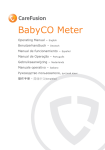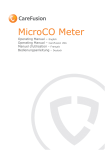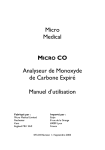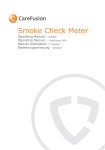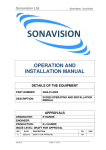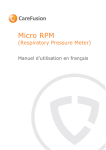Download CareFusion Smoke Check Meter Specifications
Transcript
BabyCO Meter Operating Manual Contents Overview ................................................................................. 2 Introduction ............................................................................. 2 Cigarette Consumption .............................................................. 3 Package Contents ..................................................................... 5 Operation ................................................................................ 6 PC Connection .......................................................................... 8 Calibration ............................................................................... 9 Battery Life .............................................................................13 Internal Battery Expiry .............................................................13 Cleaning .................................................................................14 Servicing ................................................................................14 Consumables / Supporting Products ...........................................15 Caution ..................................................................................15 Symbols .................................................................................15 Environment ...........................................................................16 Specifications ..........................................................................16 Customer contact information ...................................................18 1 Overview The BabyCO meter is a hand held battery operated device used to measure the concentration of carbon monoxide, CO, on the breath and calculates the percentage of carboxyhaemoglobin, FCOHb, in the foetus’ blood. It is used in smoking cessation clinics, GP’s surgeries, and antenatal clinics. In smoking cessation clinics it is used for instructional purposes and to check on the clients progress and compliance. It is accurate, easy to use, and has many features designed to simplify its operation. These include: Auto zero function Smoking level colour light indicators Simple calibration Serial interface to PC Please note: It is recommended that this unit be calibrated upon receipt Introduction The BabyCO meter is based on an electrochemical fuel cell sensor, which works through the reaction of carbon monoxide (CO) with an electrolyte at one electrode, and oxygen (from ambient air) at the other. This reaction generates an electrical current proportional to CO concentration. Output from the sensor is monitored by a microprocessor, which detects peak expired concentrations of alveolar gas. This is then converted to % foetal carboxyhaemoglobin (%FCOHb) using the relationship %FCOHb = 0.313*Expired CO (ppm). This relationship is derived from data supplied by the Centre Hospitalier d’Arras, Maternité Georges Pernin, Arras, France1. The results are displayed on a clear LCD display. 2 Warning lights are provided to give an instant indication of the smoking level. The warning light levels are user adjustable when the unit is connected to a PC running COBRA software. References 1. Gomez C, Berlin I, Marquis P, Delcroix M. Expired air carbon monoxide concentration in mothers and their spouses above 5 ppm is associated with decreased foetal growth. Preventative Medicine 40 (2005) 10-15 Cigarette Consumption The BabyCO meter provides a simple screening test for cigarette consumption for use in anti-smoking clinics and all smoking cessation programs. Measurement of carboxyhaemoglobin has been well validated as an indirect measure of cigarette consumption and is widely used in smoking cessation programs. Typical values for carboxyhaemoglobin and expired CO in smokers together with the alarm light status, are given below: CO(ppm) Cigarette consumption Indicator 0–6 Non smoker Green 7 – 10 Light smoker Amber 11 - 20 Heavy smoker Red 20+ Heavy smoker Flashing red with alarm 3 Please note that some urban areas may have high environmental levels of CO. This can cause a rise in exhaled CO of a few ppm above that which is normally present on the breath. In these cases it is possible for a non-smoker to appear at the bottom of the ‘light smoker’ range (7 – 10 ppm). The above table applies when the unit is measuring expired CO with the switch in middle position. When measuring FCOHb, with the switch in the top position, the red indicator will illuminate whenever the expired CO measurement is 7 ppm and above. References 1. Carbon monoxide in breath in relation to smoking and carboxyhemaglobin levels. Wald NJ, Idle M, Boreham J, Baily A Thorax 1981; 36, 366-369 2. Definition of a reliable threshold value for detecting current smokers by CO measurement Marino Luigi; Latini Roberto; Barbano Gina; Bazzerla Giorgio; De Luca Anita, Nardini Stefano - Respiratory and TB UnitGeneral Hospital- Via forlanini, 71-I-31029-Vittorio Veneto (TVITALY). 4 Package Contents The BabyCO meter is supplied with a carrying case containing the following items: 1. BabyCO meter (Cat No. 36-BC01-STK) 2. 22 mm mouthpiece adapter (Box of 10 Cat No.36-PSA2000) 3. 22 mm reducing connector for calibration (Cat No.36-MEC1007) 4. PP3 Battery (Cat No.36-BAT1002) 5. Disposable mouthpieces (Box 250 Cat No.36-PSA1200) 6. Calibration tool (Cat No. 36-MEC1184) 1 2 3 FCOHb CO OFF 4 5 6 5 Operation For accurate results the BabyCO meter should be used at room temperature. If the instrument has been stored in cool or hot conditions then allow time to reach room temperature prior to use. Install the PP3 battery by sliding open the battery cover, clipping the battery in place and replacing the cover. Insert the mouthpiece adapter into the BabyCO meter and then insert a disposable mouthpiece into the adapter. Turn the unit on by pushing the slide switch to the middle position (CO). The display will show the software version number momentarily whilst correction for ambient levels is executed. During this time the unit must not be exposed to any source of CO. The buzzer will then sound and the display will change to: BLOW Upon hearing the buzzer instruct the subject to inspire fully and hold their breath for as long as is comfortable. The breath-holding period is recommended to allow time for equilibration of alveolar gas. The subject should then seal their lips around the mouthpiece and exhale slowly and fully. After emptying the lungs completely the display will show the expired CO concentration in the expired air in parts per million (ppm): 6 ppm CO Provided the subject is not too distressed after seeing the breath CO measurement, then the calculated foetal carboxyhemaglobin level may be displayed by pushing the slide switch to the top position (FCOHb): % FCOHb The unit must not be used, however, for one second after the unit is first switched on i.e. before the display shows ‘BLOW’. Expired alveolar gas is then entrapped between sensor and mouthpiece valve. The display reading will rise to a plateau over the course of several seconds. The final value will be held until the unit is turned off and represents parts per million CO or %FCOHb depending on the slide switch position. The lights will come on according to the table on page 3. Important note: Before repeating a measurement the unit must be turned off, and the mouthpiece and adapter removed for at least 1 minute. This is to allow re-equilibration with ambient air and to dry the surface of the sensor. Visually inspect that all moisture has evaporated from the surface of the sensor before reuse. 7 If the unit is switched on again too quickly after use there may be a response to residual expired carbon monoxide from the previous test. In this case the display will show: If this is displayed then turn the unit off, remove the mouthpiece adapter, and expose to ambient air for 2 minutes before repeating the test. Note: If this warning appears again after following the above procedure then turn off and leave the sensor exposed to ambient air for a further 3 minutes. If the same message appears again then this indicates possible contamination of the sensor with a solvent. In this case remove all sources of solvent from the vicinity of the sensor and expose to ambient air for 24 hours before switching on again. PC Connection The BabyCO meter may be connected to the serial port of a PC running COBRA (CO Breath Analysis) software. This software allows the measurements to be read by a PC and automatically entered onto a pre-defined report for subsequent printing and filing. It also allows the CO level indicators and the breath holding countdown timer to be configured to individual requirements. 8 Note: the BabyCO meter should only be connected to a computer that is manufactured in accordance with EN60950 1992/1993 – ‘Safety of Information Technology Equipment including Electrical Business Equipment’. Calibration Calibration will remain stable to within 2% over one month and typically to within 10% over 6 months. CareFusion supplies calibration gas (20ppm CO in air) and recommends that the unit be recalibrated on a 6 monthly basis. See page 15 for calibration accessories. To carry out the calibration locate the calibration switch on the righthand side of the instrument as shown below. Serial port Calibration Switch Push the slide switch to the CO - PPM position and wait for the unit to display zero. Screw the control valve firmly onto the cylinder and connect the gas supply as shown below: 9 Plastic Tubing Control Valve Flow Indicator Reducing connector for for Calibration 20 ppm carbon monoxide in air The plastic tubing supplied with the gas should be pushed firmly over the reducing connector. Slowly turn the control knob anti-clockwise until the ball in the flow indicator is between the two marks. This will then supply a gas flow of approximately 0.25 l/min. Apply this flow for 25 seconds and if 10 the meter does not read 20ppm use the calibration tool to push the calibration switch. The unit will then beep 3 times, store the new calibration value, and display the following: The gas supply should then be turned off. If the signal from the CO sensor is too low a new calibration value will not be stored and the display will show: The most likely cause for this is an expired cell but may also be caused by depressing the calibration switch with no gas applied. Ensure that the concentration of calibration gas is correct (20ppm), that the connections to the gas cylinder are secure, and that the gas cylinder is not empty, and then repeat the calibration procedure. If the above message is repeated, the BabyCO meter must be returned to CareFusion Ltd, or an authorised agent, for sensor replacement. 11 Sensor life ranges from 2 to 5 years and depends upon both the amount of exposure to CO and other gases, particularly solvents such as alcohol and cleaning fluids. If the signal from the CO sensor is too high, a new calibration value will not be stored and the following will be displayed when calibration is attempted: The most likely cause for this is using an incorrect concentration of calibration gas. Ensure that the concentration of calibration gas is correct (20ppm), that the connections to the gas cylinder are secure, and then repeat the calibration procedure. In order to stop any gas leak from the can after calibration, ensure that the control knob is tightened firmly. Important Notes: • Only certified calibration gas from a reputable source should be used. • Ensure that no CO is present on the sensor for 3 minutes before starting the calibration procedure. • Ensure that the instrument and gas cylinder have stabilised at room temperature before calibrating. • Do not immerse the unit in the calibration gas. 12 Battery Life Battery life is approximately 30 hours of continuous use. When the battery has approximately 1 hour of useful life left the alarm will sound momentarily after the unit is first switched on and the following message will be displayed: When the battery has completely expired the above will be displayed continuously and the battery must be replaced. Note: Please remove the battery if the meter is likely to be unused for more than a month. Internal Battery Expiry The BabyCO meter has an internal battery with a life of approximately 10 years. This battery supplies the sensor signal conditioning circuit continuously to ensure instant start up. When the battery has expired, the following warning message will be displayed: and the alarm will sound when the unit is first turned on. 13 When this occurs, the BabyCO meter must be returned to CareFusion, or an authorised agent, for battery replacement. Cleaning The mouthpiece adapter may be cleaned using a mild detergent solution or replaced if there is risk of contamination. Exposed surfaces of the meter, other than the sensor surface, may be wiped with a clean, damp cloth. It is recommended that this procedure is performed after each use and all used cardboard mouthpieces discarded. Important note: The sensor surface must not be wiped with any aqueous solutions and must not be exposed to solvents e.g. alcohol or permanent damage may result. Servicing If your unit requires service or repair please see page 18 for contact details. A full service manual including circuit diagram and parts list is available upon request. 14 Consumables / Supporting Products Cat. No. Description 36-PSA1200 22mm disposable cardboard mouthpieces (250 per box) 36-PSA2000 22mm mouthpiece adaptor (pack of 10) 36-BAT1002 Alkaline PP3 Battery 36-MEC1184 Calibration Tool 36-MCG020 MicroCan calibration gas canister 20 litres of gas in a 1-litre canister. 20ppm Carbon Monoxide in air 36-MGA222 Stainless steel valve for calibration canisters with flow indicator 36-MEC1007 22mm reducing connector for calibration 36-CAB1000 Interface cable for COBRA software Caution Mouthpieces are single patient use. If used on more than one patient there is a risk of cross-infection. Repeat use may degrade materials and lead to an incorrect measurement. Symbols Type B device In accordance with Directive 93/42/EEC 0086 Disposal in compliance with WEEE 15 Environment This instrument complies with directive EN60601-1-2 electromagnetic compatibility but can be affected by cellular phones and by electromagnetic interference exceeding levels specified in EN 50082-1:1992 Specifications Sensor type Electro-chemical fuel cell Range 0 - 100 ppm Resolution 1 ppm Green indicator light 0 to 6ppm Amber indicator light 7 to 10ppm Red indicator light 11 to 20ppm Flashing red light 20+ Accuracy +/-5% of reading or 1ppm whichever is the greater Sensitivity drift 0.5%/°C Sensor life 2 to 5 years Response time < 15 sec (to 90% of reading) Hydrogen cross sensitivity <15% Operating temperature 15 - 25 °C Operating pressure Atmospheric +/- 10% Pressure coefficient 0.02% signal per mBar Relative humidity 15 - 90% continuous (Non condensing) (0 - 99% intermittent) Baseline drift 0ppm (auto-zero) Long term drift < 2% signal loss per month Power source Single Alkaline 9 volt PP3 Main battery life 30 hours of continuous use equivalent to approximately 2000 tests Internal battery life 10 years Weight 180 g (Including battery) 16 Dimensions 170 x 60 x 26 mm Display 3 ½ digit LCD Storage temperature -20° to +70 °C Storage humidity 30% to 90% 17 Customer contact information UK Customers only For all Sales Order processing for products, training and spare parts, Service and Technical Support enquiries, please contact the following: CareFusion UK 232 Ltd UK Customer Service & Support The Crescent Jays Close Basingstoke RG22 4BS Customer Service Sales Enquiries: Telephone: 01256 388550 Email: [email protected] Factory Repair and Administration Enquiries: Telephone: 01256 388552 Email: [email protected] Technical Support Enquiries: Telephone: 01256 388551 Email: [email protected] International customers only For all Sales Order processing for products and Spare parts, Service and Technical Support enquiries, please contact the following: Carefusion Germany 234 GmbH Customer Service & Support International Leibnizstrasse 7 18 97204 Hoechberg Germany Customer Service Sales Enquiries: Telephone: 0049 931 4972 670 Email: [email protected] Factory Repair and Administration Enquiries: Telephone: 0049 931 4972 867 Email: [email protected] Technical Support Enquiries: Telephone: 0049 931 4972 127 Email: [email protected] 19 CareFusion UK 232 Ltd., Quayside Chatham Maritime Kent ME4 4QY U.K. 0086 JDE no. 36-MAN1222 Drg no. 113-09 Issue 1.5 February 2010 © CareFusion 2010
























